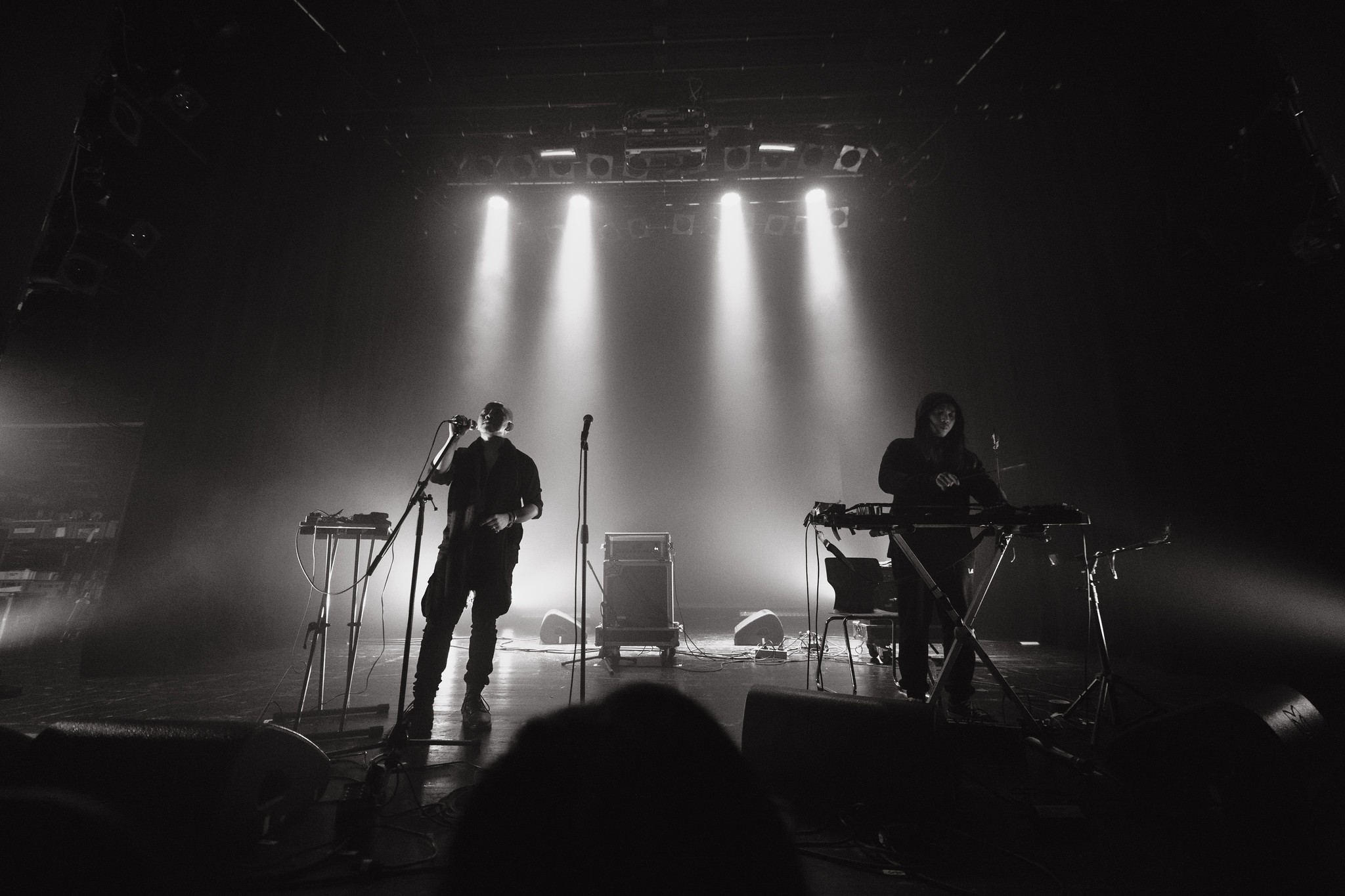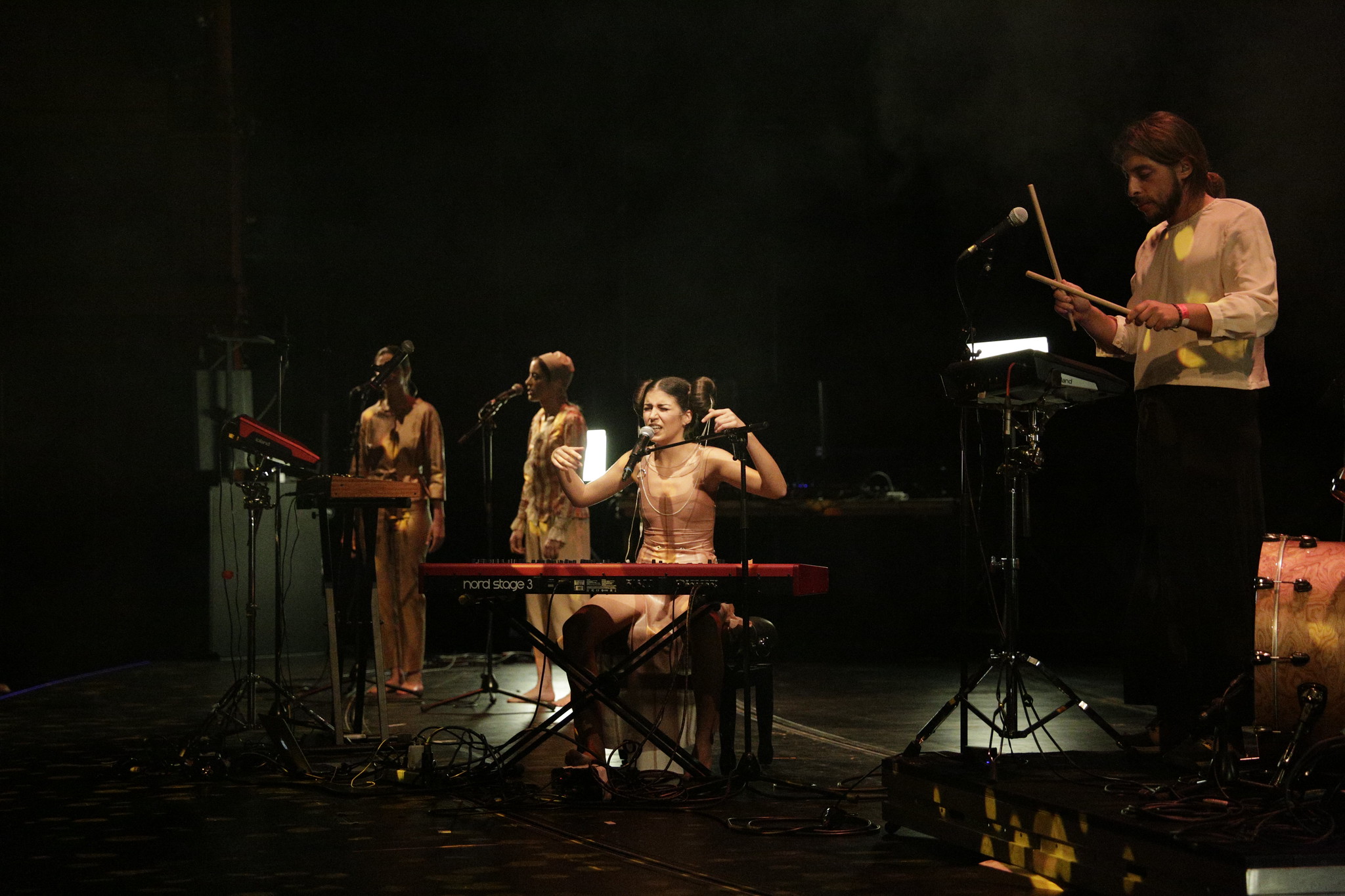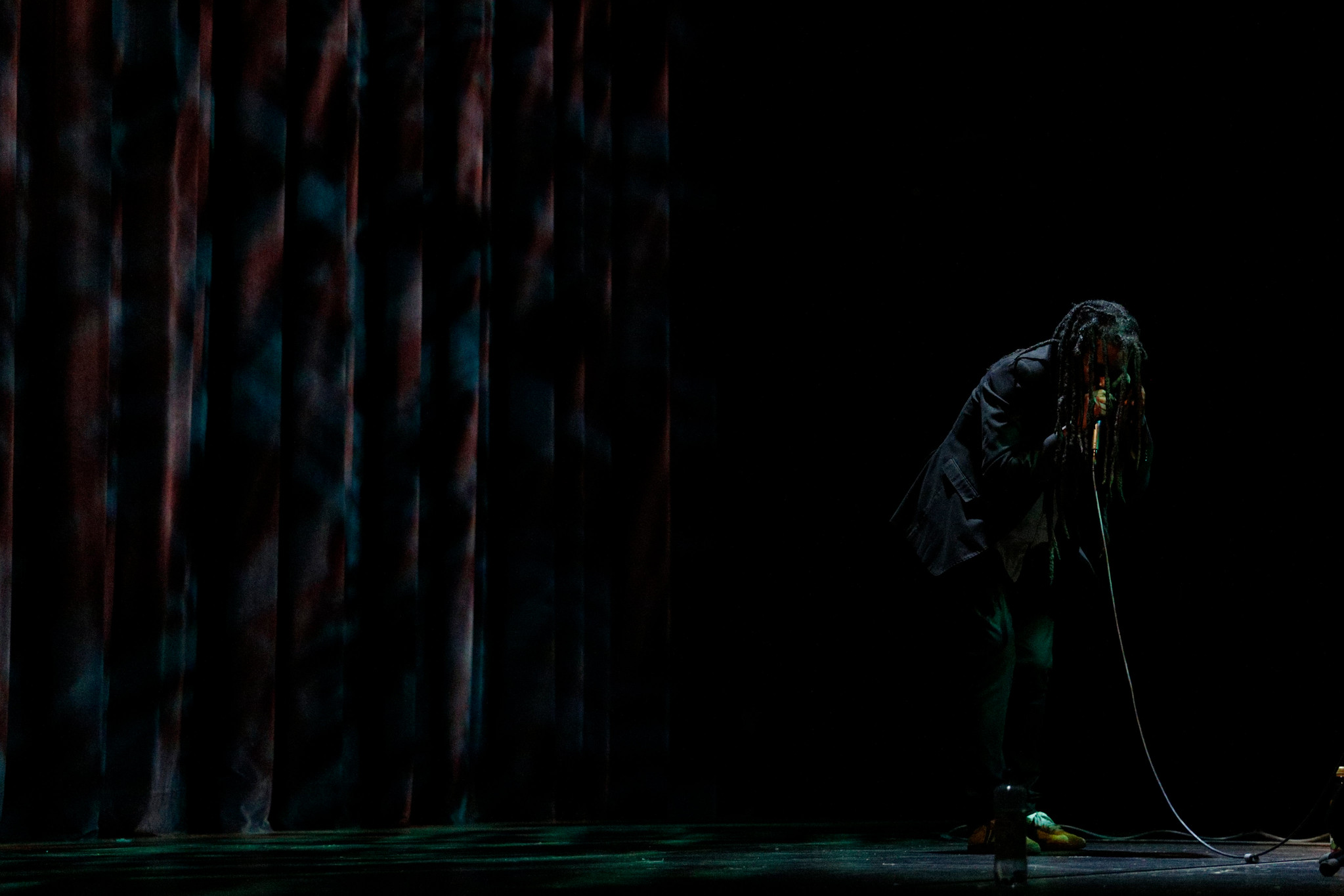CTM 2022: Contact Traces
Sumugan Sivanesan
July 2022

Senyawa at Heimathafen Neukölln, May 29, 2022, CTM Festival 2022 © Camille Blake / CTM Festival.
Rully Shabara, of the Indonesian duo Senyawa, hosted a workshop, “Shout! Make Yourself Heard,” for CTM 2022 Part 1. Proposing that shouting is more than simply making noise, he explained how such nonverbal expressions are effective modes of communication. Giving the example of waiting in the queue to enter Berlin’s renowned Berghain nightclub – notorious for its weekend crowds and discerning door staff – Shabara asked what would be more efficient if someone cut in the line in front of you: Would you confront them with a polite rebuttal or a startling “Oi!”? While Shabara’s partner in Senyawa, Wukir Suryadi, invents and builds his own unique instruments, the self-taught singer told us that his body is his instrument. By adjusting his breath and posture and honing special techniques he has learned how to play it. Taking us through some simple breathing techniques, the workshop culminated as a collective scream as we all let loose over Zoom.
In February, during the first part of CTM’s 2022 program, Shabara was in Jakarta, and participants from different parts of the world came together online. For CTM Part 2 in May, Senyawa traveled to Berlin for two performances, and those of us privileged to be here experienced the band in the flesh. When Senyawa took to the stage at Heimathafen Neukölln for the festival’s closing concert on May 29, Shabara opened up with a deep belly groan that ascended into piercing nasal overtones in one long breath. I was ordering a drink at the bar, and for a moment the whole place stood still. Senyawa could not be ignored; they took possession of the room and there was something that compelled us all to look that I can’t attribute to volume alone. Arguably, presence is a quality of (music) performance that brings together a range of intangible attributes such as charisma, confidence, and timing, and that also reveals aspects of representation that are not obvious in sound alone.
With the return to live events after CTM 2021 was convened entirely online, I, like many others, have come to appreciate what is unique about the communal music experience. CTM 2022, themed “Contact,” was concerned with how “music holds spaces for us, where freedom, closeness, exuberance, and community are within reach.”1 Such attributes of music frame inequalities reinforced during the pandemic for those unable to isolate and those who could not afford to lock down. In the context of Covid, “contact” corresponds to a contagion that is airborne and alludes to anxieties about sharing space and breathing the same air. Music also travels through air, and the ethnomusicologist Steven Feld claims that sound is a haptic sensation as changes in air pressure vibrate our eardrums.2 Indeed, music has long been mediatized and distributed in such a way that we are often “touched” by recorded or broadcast sounds, but there are other aspects of music performance that forge sonic cultures and aesthetics. The burgeoning philosophy of somaesthetics proposes that our bodies are an indispensable “tool of tools” and so by enhancing our bodily perceptions we may improve our quality of life.3 In my early attempts to write about dance, I was advised that rather than trying to “read” the performers’ movements I should attend to how they registered in my body; how did they make me feel? So while I consider how music affects me as an audience member, I am also keen to emphasize how audiences are receptors and, indeed, hosts for sounds. In particular, I was struck by the range of singing practices represented at this year’s festival.
The sixty-five-year-old Sainkho Namtchylak was born in Tuva, a Russian republic bordering Mongolia, where she trained in Khöömei singing – using her lips, mouth, tongue, and nose to produce distinct sounds. It is a technique taught by master to apprentice that was supposedly learned from birds and is associated with shamanic practices.4 Now based in Vienna, Namtchylak performed on Berghain’s main stage on May 25 with Slumberland, also known as sound artist Jochem Baelus. Dressed in frayed denim and distinguished with a bushranger beard, Baelus performed as a one-man band, leaping enthusiastically between two wooden tables supporting his self-made contraptions. He beat out rhythms on metal plates and stabbed at a toy keyboard attached to a hose pipe while stomping on loop pedals with black work boots. Sporadically, he would lunge at a long loop of wobbly steel, coaxing out different sounds by smashing it with a stick or caressing it with a bow. While Baelus is a captivating performer and his steampunk assemblages took up the majority of the stage, everyone was fixated on the slight, older woman positioned off to the side. Dressed in skintight black sports clothes, a patterned baseball cap, and wide sunglasses, Namtchylak switched effortlessly between cabaret melodramatics and gastric growls that would make Burzum blush, demonstrating her extraordinary seven-octave voice.
Following the concert, Namtchylak announced that she would sell CDs at the side of the stage. “Who has a CD player these days?” I wondered aloud, and others around me smirked. Nevertheless, a queue quickly formed as those blown away by Namtchylak’s performance sought her presence. Someone I’d never met took my arm and asked me to accompany her. She was awestruck, divulging that she felt like Namtchylak was screaming for her, releasing the pent-up emotions she had welling inside. “Do you think she is channeling something?” she implored. I shrugged. Another fan, who I later learned was a performance scholar and curator, told Namtchylak, “When you cried on stage I was crying with you.” When the weary Berghain staff urged us to leave, a few of us retired to a bar. No longer strangers, we discussed the demands placed on professional singers to summon up their vulnerabilities and release them onstage for the audience’s catharsis.

Marina Herlop, CTM x Volksbühne am Rosa-Luxemburg-Platz © Stefanie Kulisch / CTM Festival 2022.
By contrast, Marina Herlop, who performed at the Volksbühne on May 27, is a young Catalan composer and vocalist, classically trained as a pianist. If Namtchylak’s music speaks of experience and her relatively long career, Herlop’s oeuvre is often described as “otherworldly.”5 She arrived on stage with her hair secured in two Princess Leia buns, her slim figure sheathed in a sheer flesh-colored slip. Herlop’s troupe of two singers and a drummer also dressed in the same tonal palette. Herlop’s music is novel – delightful – and her band is expressive in a way that suits the theater stage. They are cute, although I don’t doubt that their playfulness and “light touch,” which prompted a standing ovation, are the result of serious training and attention to detail. Moving between two electronic keyboards, a drum pad, and a laptop, Herlop sang in a language I cannot fathom. “Made-up words” is how one reviewer describes her vocalizations, which are informed by Konnakol, a “language” used to voice rhythms in South Indian Carnatic music.6 I am intrigued to read that Herlop’s recent album Pripyat (2022) takes its name from the Ukrainian city abandoned after the 1986 Chernobyl nuclear power plant disaster. Pripyat is her third release and the first to be made entirely on a computer. She explains her aesthetic concerns in a recent interview: “Humans interpret sounds, but music itself is self-sufficient.”7
Coincidentally, Nakul Krishnamurthy, who performed in Berghain before Namtchylak and Slumberland on May 25, was trained from a young age in Carnatic music. While the composer also makes use of his voice, he performs on a laptop, layering and processing recordings with the popular music production/performance software Ableton Live. Krishnamurthy’s voice might be perceived as disembodied, but it is certainly not ethereal. Performing compositions from his recent release Tesserae (2020), Krishnamurthy wrenched rich sonorous tones from his computer that rang out loud and clear from the club’s powerful surround sound system. The beating and phasing of closely aligned frequencies were palpable as sliding, spatialized voices interweaved.
In conversation with journalist and musician Daniel Spicer the following day – during CTM’s discourse program, “Music & Sociality” – Krishnamurthy challenged the hegemony of both Western “experimental music” and “classical” Carnatic schools which uphold caste hierarchies. Born into a (high-caste) Brahmin family and straddling both Western and Indian music traditions, he has found a niche using one form to problematize the other. The young composer talked about resisting fixed notes, as the foundation of Western classical music theory and composition, in his attempts to reimagine the idea of the note altogether by emphasizing shifting and interacting frequencies. Furthermore, Krishnamurthy implored us to be critical of our perceptions, challenging the subtle and enduring Orientalism that has led to his music being received in experimental music scenes as meditative, contemplative, and spiritual rather than for its harmonic, melodic, and spatial qualities. Thus, he urges us to decolonize our listening practices.
Such criticisms about how we are conditioned to receive music performances prompted me to reflect on CTM’s grouping of artists representative of Ukraine on the same outdoor stage for its club night at RSO (May 28). While I understand this is a gesture of solidarity, after watching Katarina Gryvul perform to a relatively small crowd on a chilly night, I wondered why these artists were not more thoughtfully folded into the program according to their musical approaches and interests. Another young artist trained at European music academies, Gryvul sings live, looping, layering, and processing her pitch-perfect voice together with striking sound design, deftly animating the sound system with bone-crunching booms, caustic textures, and vivid phasing. I was too fidgety in the cold to be entirely subsumed by the atmospheres she conjured – nevertheless, she left an impression on me that outlasted many of the acts performing on the louder and better-attended stages indoors.

Moor Mother, CTM x Volksbühne am Rosa-Luxemburg-Platz © Stefanie Kulisch / CTM Festival 2022.
While Gryvul’s relatively obscure performance was, for me, a surprise discovery, Moor Mother’s reputation precedes her. The alter ego of Camae Ayewa, Moor Mother’s performance at the Volksbühne on the same bill as Marina Herlop and Space Afrika (May 25) was delayed due to a flight change. Following Space Afrika’s downtempo, seemingly non-performative, live audiovisual collage, the audience was asked to leave the auditorium so that Ayewa could set up and quickly sound check. Thirty minutes or more later, the bar had sold out of bretzels and we were summoned back to our seats, clutching our drinks in plastic cups in anticipation. Moor Mother took to the stage and gripping two microphones, she began: “Nobody wants to be Black life . . . shit’s fucked up.” A shuffling collage of beats, textures, and samples piped out of a laptop sitting on a table alongside effects pedals that I assume she was using to alter her voice.
Moor Mother prowled around the stage, leaning into the microphones, rocking back and forth, churning time. While repetition begot rhythm, sentences loosened their structures and words came apart as sounds. Vocal effects that dither and distort enhanced this process, yet certain phrases leaped out in sharp focus: “If you knew how many times it took me to get here, to this place right in front of you . . .” Rhythm also has a hypnotic effect, and I relinquished focus in favor of reception. I wondered if Moor Mother was chanting down obstacles, oppressors, and opponents, or if her mantras summoned ancestors. Looping is deceptively circular, as it seems to open up other aspects of space-time; other dimensions. So, it was frustrating when her set ended abruptly a little before midnight. Whatever Moor Mother had begun didn’t feel like it was yet done. “She could have gone on for at least another half hour,” I told some friends preparing to leave in the lobby, and they concurred. She could have gone on all night, yet the regulatory function – indeed, the disciplinary instrumentalization of time – stressed the very issues of structural racism, anti-Blackness, and intergenerational trauma that Ayewa addresses.
The concert is a space of communion and exchange – a space for affective intensities – that might lead to transformation and catharsis. While musicians are under pressure to perform and often undertake rigorous training to do so, experimental or “adventurous” music also pushes audiences’ expectations, challenging their preconceptions. So, do we also need (re)training? Somaesthetics suggests that by cultivating our sensibilities we may listen better and thus expand our capacities for what sound and performance can do. Music is not only entertainment but exposes us to other cultures, new ideas and different ways of being. Indeed, music might tune us – like instruments – to alien or ancient desires, or prepare us for what is to come. Leaving the Volksbühne, I rode off into the rainy night, back toward Berghain, wondering how to turn oneself into a time machine.
Footnotes
- “CTM 2022 Festival Theme,” CTM, accessed July 16, 2022, https://www.ctm-festival.de/festival-2022/theme.
- Steven Feld, Sound and Sentiment: Birds, Weeping, Poetics, and Song in Kaluli Expression, 3rd ed. (Durham, NC: Duke University Press, 2012).
- Richard Shusterman, Thinking through the Body: Essays in Somaesthetics (New York: Cambridge University Press, 2012).
- “Mongolian traditional art of Khöömei,” UNESCO Intangible Cultural Heritage, 2010.
- See, for example, Henry Bruce-Jones, “Marina Herlop marries Carnatic rhythms with cow births in ‘miu’,” Fact, 2021.
- Joseph Francis, “Marina Herlop – Pripyat,” Resident Advisor, June 21, 2022, https://ra.co/reviews/34932.
- Herlop cited in Günseli Yalcinkaya, “Marina Herlop, the Catalan musician imagining a world without humans,” Dazed, May 22, 2022.
Sumugan Sivanesan is an anti-disciplinary artist, researcher and writer. Often working collaboratively his interests span migrant histories and minority politics, activist media, artist infrastructures and more-than-human rights.